#Revisionary
Explore tagged Tumblr posts
Text

vote yes if you have finished the entire book.
vote no if you have not finished the entire book.
(faq · submit a book)
6 notes
·
View notes
Text
invited to write an essay for an edited collection, edited collection gets spiked by reviewer. i am invited to write an essay for a second edited collection. unbeknownst to me, reviewer/spiker of first edited collection is editor of second collection (or best friend of spiker).
i write essay. editors request heavy revisions. i rewrite essay. editors say i've revised it too much and i need to go back to the first draft and revise it again. i ask when they want it by. no response. i email again and they give me 3 weeks during term time. lol.
truly i hate this essay now and have been working on it for the past few days, and i intend to finish this fucking thing today and it's going to be a bitter and angry essay but I will make it good
11 notes
·
View notes
Text
Maycomb Blume and "Reading" Loveless in Rebirth
Heya, folks. SPOILERS ahead for Rebirth. Loveless is the only thing that should be spoiled, but I do mention foreshadowing for another event without stating the event.
Content Warning: Death is mentioned, and there is an image of a skull being held by David Tenant. This should be the only time I have to provide a David Tennant warning on this blog /s.
I've let this blog go dormant since I started it and emptied it out, but I wanted to use it. Originally, I started this blog to chronicle my readings of FF7, FF8, and FF9 as adaptations of Xiyouji, but that didn't feel like an easy thing to start with.
I did have the first section of a close reading of Loveless as it appears in English posted here, but I wanted to restart with pointing out how "reading" video games more deeply can be rewarding and is something you probably already have the tools to do if you went to primary school in the past 30 or so years. I will throw the close reading back on here when I've edited it, but I want to be doing something with this blog that isn't quite so deeply analytical to start. I also like adding images to break up text, and this is one of the few places I can do that with alt text for accessibility. Tumblr doesn't like outside links, though, so win some, lose some.
I wanna focus on Loveless from Rebirth with one critical lens among many that you can use to find your own meaning from it. You can even use weaker lenses, like the monomyth and its mother goddess guiding a hero or a Wagnerian reading, if you want. Loveless is a story about heroes on the stage set to music, even if it doesn't neatly line up with either lens. One could display how it resists interpretation by those lenses, for example. In any case,
You Probably Already Know About Literature
Loveless is a play. Even being in a game, it is a play that bears features common to European and American plays and operas from the 16th Century to the modern day. While some parts may be foreign to what you were taught in school, like the operatic portion at the beginning and the lead-solo at the end, the three-to-five act structure with exposition, rising action, climax, and falling action is something quite common to primary education in a lot of countries.
If you were taught this in primary school, you were probably also taught it through a few key authors, artists, directors, and playwrights. If you're from the US, those names likely included some people like James Baldwin, Harper Lee, Kurt Vonnegut, and maybe a few authors from South America like Julio Cortázar or Laura Esquivel. Without doubt, though, I bet you had to read Shakespeare.
That isn't without good reason. Regardless of what you think about him or his works, Shakespeare's words have been enjoyed and remade countless times around the world in many languages. His dominance of theater of a European style is to the point that some of his lines in isolation, ripped of their context, are enough to call to mind the drama on stage to much of the world.
If I say "To be or not to be..." most native English speakers are already finishing the line or jumping ahead to picture a skull in hand, dramatically lamenting a fellow of infinite jest who now has none who would mock his grin. I've seen the same happen with "Ser o no ser..." and "Sein oder Nichtsein..." in non-literary conversations.

David Tennant not mocking Yorick's grin as Hamlet. Image retrieved from Yorick on Wikipedia, originally from BBC article Bequeathed skull stars in Hamlet.
But, that aside, a piece of Loveless begins before the play, somewhat like the earlier events of Hamlet reflecting in his own play within a play.
You Probably Already Know How to Find Out More About Literature.
If you went to school in the age of the internet, you probably had to do research online to back up your writing in an essay on some piece of media you might not have cared about. Maybe you just found a website, reputable or not, that made an argument you could pull a quote from and stick in your writing. Hopefully, though, there was at least a time or two where you genuinely connected with a piece of assigned media and wanted to see what you could find from scholars about the plot, symbols, style, etc. to inform and elaborate on your own thoughts. I want to do that second one with Aerith's pseudonym for the solo at the end of Loveless, Maycomb Blume.
If you put "Maycomb Blume" into a search engine, I'm using Google through a VPN on a clean device, you're probably going to see a wall of FF7-related pages discussing the name. Unfortunately, those aren't the best sources for doing more than stimulating reflection on your own ideas. Most of them seem to come to a homophonic conclusion that it sounds like "make em bloom" that first appeared on a fan Twitter account. However, you might see an article or two about a book by Harper Lee set in the fictional town of Maycomb, Alabama - To Kill a Mockingbird.
If you look into them, you'll see that they tend to be reflecting on the resistance, or lack thereof, to oppression present in the novel by its protagonists. At first, that may seem tenuous, but let's follow the string and look into the Maycomb part of Maycomb Blume. A large piece of Final Fantasy VII is resistance or lack of resistance to oppression bringing characters together or pushing them apart, after all.
If you look up 'Maycomb' by itself, you will quickly find that it almost exclusively refers to the fictional town of Maycomb invented by Harper Lee. Google Ngram Viewer confirms this, showing virtually zero mentions of 'Maycomb' until the release of To Kill a Mockingbird. As a deliberate choice of translation, they sure did pick a unique word, no? But what about the "Blume" part? That isn't exactly an uncommon word, and it has myriad variations.

The results of a Google Ngram Viewer search for Maycomb, showing the sudden increase in the appearance of the word Maycomb in text after Lee's publication. Image screenshot from Google Ngram Viewer on October 19, 2024.
If you keep digging and do more looking, you might find that one of the most famous, influential, and controversial literary critics, Shakespeare scholars, and Harry Potter-haters in the world, Harold Bloom, was the editor for an anthology of critical essays on To Kill a Mockingbird. If you know anything about him, you might be aware of his idea that all works of literature are essentially "remakes" that carry influence from the ideas and stories they are latecomers to. This idea is what he called the anxiety of influence.

Harold Bloom, the man who hated Harry Potter before it was cool. Image retrieved from Wikipedia, by Bernard Gotfryd and originally obtained from the page Bernard Gotfryd on the Library of Congress website.
So what did Bloom have to say about Lee's most famous work in this text? Not much, as he was the editor of the volume, but he did say that the protagonists weren't what one would call heroes, but reflections of a sensibility that saw itself without the need to change in the face of racism:
The crises of [Scout’s] book confirm her in her intrinsic strength and goodness, without wounding her sensibility or modifying her view of reality.
So, where our initial look might lead us to a simple homophonic "it sounds like 'make em bloom,'" our deeper look leaves us with a lens from a scholar most focused on works of poetry on the stage, the anxiety of influence, and a theme with which to use that lens with, growth of a protagonist in the face of oppression. These tools seem appropriate for a work that is explicitly part of a "remake" of an earlier work that deals heavily with oppression, how people do or do not resist it, and what that leads them to do - so how well do they apply to Loveless?
You Probably Know How to Apply This to Loveless
Again, if you went to primary school in an English-speaking country in the past 30 years, you were probably taught the basics of how to apply critical lenses to any media you consume. If you had to read A Modest Proposal and discuss how well Jonathan Swift satirizes the plight of the poor in Ireland and upper-class reactions to it, you were being exposed to rudimentary Class or Marxist Criticism. In the US, you might have also been exposed to it while reading The Great Gatsby or The Grapes of Wrath. If you had to analyze the symbols in an Edgar Allan Poe work and explain the ideas, sensations, emotions, and images they called up for you and how well they served the work as they were written, you were being exposed to rudimentary New Criticism. In the US, you might have also been exposed to it while reading Song of Myself or listening to I Have a Dream.
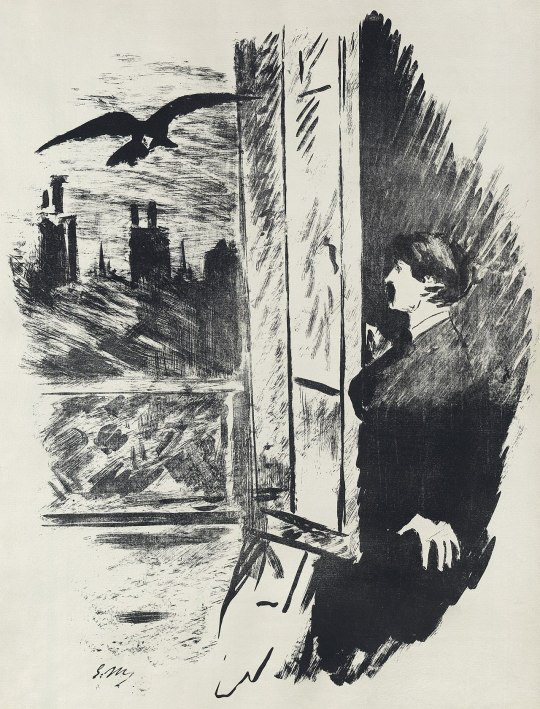
Edward Manet's interpretation of the visit of the raven, both chaotic and clear. Image retrieved from The Raven on Wikipedia, originally on the Library of Congress website linked by a dead link.
The anxiety of influence, or Bloomian criticism, is just like those lenses in that it is a tool for you to apply as an individual reader. Primary schools don't often use even rudimentary Bloomian criticism, though, because it requires a knowledge of a canon, or a body of important works at its simplest, but introducing you to a canon is part of what studying literature in primary school does. Once you have at least a familiarity with a canon, you can start to identify how works influenced by that canon build upon it to deliver their own stories in a way that might or might not change how you read those original works.
Remember how I brought up the "to be or not to be..." soliloquy near the start of this? Are you minimally familiar with Hamlet, Romeo and Juliet, and King Lear?
If yes, you can apply rudimentary Bloomian criticism to Loveless.
Actually Doing It
The operatic bit of Loveless and the title itself mirror the central tragedy of King Lear: three would-be heroes vie to prove their love for King Lear and all but one are proven loveless. Even more in-line, they are a blonde would-be hero who is imprisoned (Cordelia), a would-be hero with black hair who is slain (Regan), and a would-be hero with red hair whose life is cut short (Goneril).
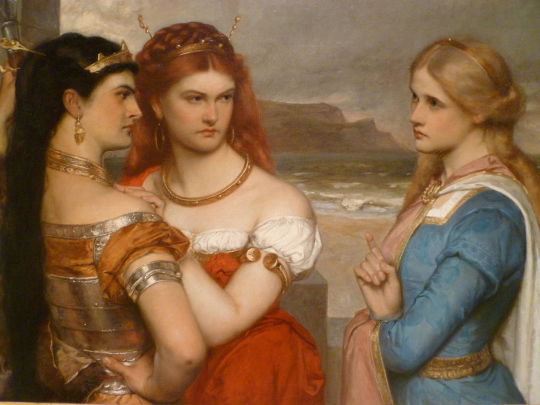
The Three daughters of King Lear by Gustav Pope. From left to right are Regan, Goneril, and Cordelia. Image retrieved from King Lear on Wikipedia.

The three would-be heroes of Loveless raising their swords. Of the three, only Alphreid on the left is given explicit name, but parallels between the three and other characters within and without the Compilation may be drawn.
While there is a "mother goddess" in the mix, understanding it here without a background understanding of possible precursors (like Campbell's mother goddess or the Guanyin of Chinese/Japanese Buddhism from which he derived it, in part) would only serve to make this longer in explanation. As it goes, she is one of the primary features of the play which connect Loveless to Final Fantasy VII as a whole, but understanding the reason for her inclusion is impossible without looking at FF7 as a whole. As it stands, Loveless can be understood as a work in its own right in a similar way to how Hamlet's play can be understood as a character in the play rehearsing his own mode. That is; Loveless is informative even without understanding Remake and Rebirth in whole.
Already, though, we see that we've reached the point of tragedy of King Lear: it is not long after the imprisonment of Cordelia that she is hanged and her father dies of grief and madness. The Fool, though, appears to deliver the reveal of Bloomian clinamen, the swerving away an author (or authors) makes from the precursors when they create their own misprison (work of art/poetry/literature/etc).
Where King Lear ends shortly after Cordelia's imprisonment, Loveless only truly begins there, and the Fool, a character used to communicate the true nature of things, appears. It is fitting, then, that the character who communicates the true nature of things appears again here as the only character without change or loss in title, being the Fool in both King Lear and Loveless. He introduces us to Alphreid, who himself calls back to the madness of loveless Shakespearean tragedies with his "To proceed... or not to proceed!" line after the tutorial.
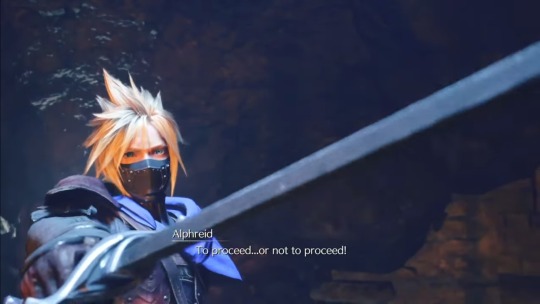
Cloud as Alphreid putting on his theater shoes and reminding the reader of the question.
Where Hamlet and Cordelia are condemned to tragedy because of their rejection of love or the rejection of their love, though, Alphreid is freed and empowered by his newfound acceptance of the Goddess' love through the hand of Rosa. This reveals the tessera of the work, the fragment that can be used with other fragments of the work to show where the author (or authors) suggest that the precursors did not go far enough. Hamlet and King Lear, then, are filled with nothing but villains and victims who refuse to embrace the power of love of all things. This makes sense, as those were tragedies.
This blends with the daemonization the work employs, a Counter-Sublime in reaction to the Sublime of the precursors. This is the evidencing of the tessera from before in the way even nature, thundering with Alphreid's rally, reveals in Loveless the counter to the Shakespearean idea that lovelessness flattens all. Where Cordelia and Ophelia die to lack of true love from even one person, Alphreid becomes empowered by love for all things. This reflects even in the reader's/player's ability to progress no matter who they declare their love for among Varvados, Garm, and Rosa, as love conquers all and lack of love flattens. Garm and Varvados, who refuse love, can be expected to fail as long as the player continues.
In hand with the application of the daemonization employed is the kenosis, the breaking device used by an author (or authors) to empty their own work and that of the precursors of their nature as literature. Here, the authors remind the reader that they are playing a game by forcing them to interact to continue Alphreid's story, breaking the illusion of the game's reality while highlighting that Hamlet and King Lear can be put on the shelf as well if you don't wish to continue. Yet, the reader does.
And, when they do, they find revealed in it the reality of the second-to-last revisionary ratio of the anxiety of influence, askesis, the movement stressing the individuality of the author (or authors). They find it most clearly in the Fool of Loveless, pleading with the audience in soliloquy where he calls upon central, humanizing lines of Shakespeare's Julius Caesar, Romeo and Juliet, and Troilus and Cresside to humanize the creators of his misprison and the misprisons embodied in its precursors,

Cait Sith as the Fool doing his best to evoke pathos for the reader through allusion to the end of things.
Friends, lend me your ears. (Shakespeare, Julius Caesar) Our inspiring hero's and indomitable princess's tale draws to a close. Only one act remains. Parting is indeed such sweet sorrow. (Shakespeare, Romeo and Juliet) But as they say, all good things must come to an end. (Chaucer/Shakespeare, Trolius and Criseyde/Troilus and Cressida) Though it is our wish that this tale remain with you long after we are gone.
Emphasis and parenthetical additions mine.
Almost in those words, the Fool draws the reader of both King Lear and Loveless to consider the work as its own unique and novel expression; though, the Fool of King Lear simply tasks the reader with recognizing the application of Lear's lessons. The Fool of Loveless, however, calls on the reader to keep the work as a novel piece with them even as they finish the work.
Even more, it seems to remind the reader that an end in death is soon to come, for Mark Antony was lamenting the death of Caesar in his "Friends, Romans, countrymen, lend me your ears..." speech, Juliet was foreshadowing in a good night that her cherishing might kill Romeo when she described parting as sorrow and grief, and Chaucer was describing the parting of Criseyde despite the pleas of Troilus when he said, "every thing hath ende" (which Shakespeare later modified). For all of these works, the Fool seems to be showing the ways in which this story will show an end isn't quite so simple - that a death isn't so simple as ending everything for those who survive.
The last of the revisionary ratios of the anxiety of influence, the opening of the work near the end of the author's (or authors') life that reveals the precursors' influence which is apohprades, is evident across the work in the blatant allusions we just discussed and in the name of the trilogy of works that contains it: Remake.

Cloud putting on his standoffish act as Alfred. The translation has served to better the depth, as even Alphreid is the portmanteau of Siegfried and Alberich from The Ring Cycle, highlighting Cloud's dualism.
As the creators of the 1997 release age and face death's tyranny, the anxiety of influence begets renewed misprison that causes the authors to reveal the precursors to their work with their reactions to them. Isolated to just Loveless, a reader can see a return of Shakespeare into a work that originally copied the format he used without clearly showing his presence to reveal a new reading of his most prominent tragedies. This reading, even, mirrors that of Bloom's reading of To Kill a Mockingbird: the tragedies of Shakespeare were preventable or survivable for more of the characters with the same force that could have prevented the crisis of To Kill a Mockingbird.
Why Does This Matter?
Because the curtains don't have to be blue if they mean something to you or the person that made them, and finding meaning in even just a small part of a work can reveal meaning to you in the whole and in other things you enjoy. If we can see Loveless as a take on growth through love of all things and people in the face of oppression influenced by a myriad precursors through baby's first Bloomian lens, we can do that with the Remake trilogy as a whole, even before it is completed. That, even, is just one critical lens that can be used. Jacob Geller has a critique of Midgar as presented in Remake through the lens of architecture and an Akira Kurosawa film that leans towards Class/Marxist Criticism, for example.
I know this was long, but I am rather determined to help people understand that the literacy skills and canons their teachers tried to impart on them are useful outside of reading those same canonical works. Final Fantasy VII suffers from surface-level readings (as opposed to something like Silent Hill or Outer Wilds), but we don't have to read any work like that, especially if we can evidence more deep readings with the text.
So, thanks if you read this far; though, you probably didn't need me to tell you about this stuff if you did.
If you're interested in the Xiyouji thing, it isn't my bigger project, but I'm gonna be semi-regularly posting readings of characters, locations, fiends, concepts, and events as seen in Remake and Rebirth through the lens of adapting Xiyouji. I'll probably be posting Barret Wallace as Sandy first, but it is a tossup between Red XIII as Red Boy, the Trio as the Three from Gensomaden Saiyuki, or The Crow's Nest's Colin as the Crow's Nest Zen Master after that. I wanted to start with this to demonstrate the idea in a smaller part and remind people why they were taught media literacy in school, though. The The Norse Myths That Inspired Final Fantasy VII guy, M.J. Gallagher, seems to be trying to do that in a way, too, but he went a different direction from Dragon Quest and the king of Xiyouji adaptations that come from Japan who helped make it - Akira Toriyama, the creator of Dragon Ball.
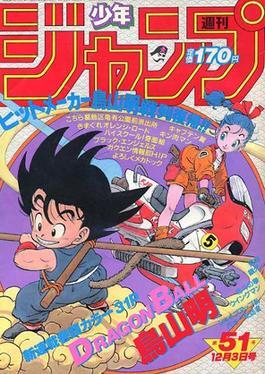
The first appearance of Goku by Akira Toriyama also beginning his journey as an adapted Monkey on a cloud towards becoming the Buddha Victorious in Strife. Image retrieved from Goku on Wikipedia.
#ff7#ffvii rebirth#ff7 loveless#ffvii remake#final fantasy 7#cloud ff7#ffvii#loveless#shakespeare#final fantasy rebirth#final fantasy vii rebirth#final fantasy vii#cloud strife#video game analysis#bloomian#harold bloom#literary criticism#new historicism#the anxiety of influence#bloomian critique#kenosis#askesis#apophrades#tessera#clinamen#daemonization#revisionary ratios#six revisionary ratios
3 notes
·
View notes
Text

“kys loser plus my bf has a gun”
#he would NOT fucking say that#he’d say something like#your ideas on communism (and marxism-leninism) are reductionary - you are a revisionary. read marx#but this is funnier#ancom.txt#left unity
8 notes
·
View notes
Text
"Revisionary History" by Alicia Witt CD
Solid album from Witt with a nice mix of songs, including a Christmas one (fitting, since she is a Hallmark Queen). Fun listen overall but not extraordinary.
0 notes
Text
I will never forgive him for popularizing the political compass but man some of jreg's music really slaps
#buzgie ❁#you're a revisionary#your regimes are quite scary!#you're a capitalist fuck#and youre a bootlicking dog#Spotify
1 note
·
View note
Note
Your post about sparkling hedgehogs.
I can't help but imagine the moment our favorite trio of humans became Cybertronians was exactly this.
Oh absolutely.
Having not experienced sparklings for millennia, it came as a bit of a kick to the teeth when the trio threw themselves into alt-mode for the first time. The team had largely forgotten about the inherent nature of sparklings, and so were expecting Miko, Raf, and Jack to transform into their vehicular modes.
They were wrong.
Raf was the first. Up until that point, he'd been calm and composed and thus had no need to transform. But after Optimus went out on a mission for a little too long, he lost it. Transforming into a ball of fury and screaming power, Raf shredded his cot, tore up the floor, and left a battered battleground in his wake. The team were initially quite helpless to stop his rampage. None of them were fast enough to grab the terror tornado and they couldn't risk getting torn up in the effort. So they let him roam, screeching and rolling around base shredding all in his path. But his panic quickly grew infectious and before the team could do anything about it, Miko also lost her cool. The stress of the situation and the beginnings of flight frame coding urged her to become stressed in sympathy, sending her careening onto the ground alongside Raf in a similar spiny destroyer.
Jack kept it together for a bit longer, but as time wore on, he couldn't help it when the stress got to him as well. The team were all but helpless as the three terrors rolled around base, forcing every bot to get on a box to avoid having shredded ankles. Ratchet made valiant efforts to gather up the trio, but lacking proper armor and not having undergone revisionary sparkling care training since long before the war, he found no success and only ended up earning a few gashes for the attempt. Bumblebee and Smokescreen tried calming the raging sparklings, but their efforts seemed to make things worse. Bulkhead and Arcee focused on defending anything delicate while Ultra Magnus, being too big to hide, accepted the shredding and did his best to herd the sparklings and keep them in one room. Wheeljack took up a place in the rafters and refused to come down. Optimus's return might as well have been the second coming of the Thirteen with how relieved the team were.
The team were quick to learn that so long as Optimus was around, there was no sign of the hedgehogs of hatred. But the instant he was registered as having been gone longer than two hours, all hell broke loose. Every. Single. Time. Well, that was at least until voice recordings were introduced to keep all three calm (at the behest of Wheeljack of all bots).
#tfp kids as sparklings#transformers#maccadam#transformers prime#team prime#ratchet#jack darby#rafael esquivel#miko nakadai#alternate universe#optimus prime#smokescreen#arcee#bulkhead#wheeljack#bumblebee#ultra magnus
182 notes
·
View notes
Text
The name Palestine, or it’s possible predecessors, have been found in five inscriptions across countries in the Levant and North Africa, all naming it Peleset or Purusati, inscribed in hieroglyphics as P-r-s-t
Their first mention is at the temple of Ramesses, 1150 BC, where Ramesses is mentioned to have fought off the Pelesets, the last known being 300 years later on Padiiset’s Statue, reading “Ka of Osiris: Pa-di-iset, the justified, son of Apy. The only renowned one, the impartial envoy of Philistine Canaan, Pa-di-iset, son of Apy.”
“Philistine” and “Canaan” both refer to the land of Palestine. The Assyrians have called it Palashtu since 800 BC, through to an Esarhaddon treaty more than a century later
The term Palestine actually comes from the writings of Greek author Herodotus in the 5th century BC, where he calls the land “Palaistine”, which is where the Arabic term “Filastin” comes from
Now, it should be noted that there is a bit of nuance in what I am about to say next - the Iron Age Kingdom of Judah did exist, and was an Israelite kingdom - this was around 960 BC to 560 BC
However, this by no means implies that Palestine is not Palestinian land - the kingdom of Judah famously fell, after all, and Israel the state was only established after political Zionism in Britain, spurred on by catastrophes like the Holocaust and pogroms, promoted the idea of a Jewish “reclaiming” of Palestine
In 1918, the Jewish Legion helped the British conquer Palestine to create the Mandatory Palestine. This caused obvious revolts, as most acts of colonialism tend to do
Over the next few decades, things went as you might know - the Holocaust meant a massive surge in Jewish refugees, most of whom were turned away by their neighbours because, well, millions of new citizens were hard to feed, and all of whom decided that Palestine was where they would go
Of course, none of this took into consideration the fact that native Palestinians would have to be displaced from their homes and livelihoods to do it, often with violence
The Holocaust was a horrible thing, obviously - but attempting to colonise a new state out of a pre-existing one, displacing and killing thousands of native Arabs, in response was hardly a good thing, either
On 22 July 1941, the Jewish militia Irgun bombed the British headquarters in Palestine, killing 91 people. This was in response to a series of raids conducted by the British ,including one on the Jewish Agency
All mediation attempts conducted over the next few years failed, as the Jewish diaspora - and more importantly, the Zionists amongst them - were unwilling to accept a solution that did not produce for them a whole new all-Jewish state in Palestine, while the native Arabs were somewhat pissed at the idea of having to leave the land of their birth due to colonialism
And it was colonialism - Zionist colonialism is still colonialism
Finally, the matter was brought before the UN, who decided to go with the Zionist idea of a separate Jewish and Arab state, with Jerusalem as an international city between them
The Irgun and other Revisionary Zionist groups rejected the idea, seeing it as an act of ceding native Jewish land. The leader of the Irgun at the time, Menachem Begin, openly stated that “the bisection of our homeland is illegal. It will never be recognized” and that the Zionists fully intended on expanding beyond their UN-set boundaries “after the shedding of much blood.”
Simha Flapan, the Israeli scholar, states that it is a myth that any Zionist groups at all accepted the partition, as most of them simply wanted to undermine the creation of an Arab state, fully intending on expanding into them later
Baruch Kimmerling, a professor at the University of Jerusalem, has stated that Zionists “officially accepted the partition plan, but invested all their efforts towards improving its terms and maximally expanding their boundaries while reducing the number of Arabs in them”
So, yes, the Zionist myth of a peaceful, unambitious Israel is exactly that - a myth
The Arabs had a much more open reaction, rejecting the plan outright. Zionists will tell you this is because they hated Jews. It’s not. Their principle argument was that it was against the principles of national self-determination set out in the UN charter, granting them the right to decide their own destiny
In any case, over on the Zionist side of things, Jewish insurgency peaked until Irgun took two British sergeants hostage as attempted leverage against the planned execution of three Irgun officers. The officers were executed as planned, and the sergeants were murdered and hung from trees. Spurred by this, the British called for an evacuation of the Mandatory Palestine
On 26 November 1947, the UN General Assembly presented another plan for the partition of Palestine, evidently fully ignoring what the actual Palestinians had to say. In this, they assigned 56% of Palestine (notably, Arab land that already had Arab landowners) to the Jewish diaspora, who had so far owned 6-7% of the land
Arabs, the majority, held 20% of the land, and the remaining 23-24% was granted to Mandate authorities and foreign entities
Once again, the native Arabs rejected this. Not because they wanted to kill Jews. But because it clearly benefitted European interests over Palestinian ones, and was thus unacceptable
Afterwards, Israel had its way and declared independence once Mandatory Palestine was dissolved. The neighbouring Arab states, formed the Arab League, and invaded, with the goal of ensuring the prevention of the Partition
To make a long story short, they failed, and Israel annexed massive parts of Palestine in the process. The native Palestinians were then expelled from the homelands by the Zionist militias in a bloody and brutal process that would come to be known as Al-Nakba
In addition, this led to the destruction of Palestinian culture, identity, and national aspirations. They were no longer “Palestinians” - they were the expelled and discarded. Their settlements were either destroyed or given new Hebrew names
In the process the Israelis would also start their genocide against the Palestinians with a bang - the poisoning of village wells and other acts of biological warfare.
750,000 Palestinians were expelled from their ancestral homes and towns - 80% of the population living in what would become Israel. Eleven Arab towns and cities, along with over 500 villages
It’s believed that around 70 massacres occurred during the Nakba, with the Yishuv killing over 800 -Arab civilians over the course of 24 of them. Other sources state that there were 10 major massacres with over 50 casualties each
The Saliha Massacre ended with 70 dead, the Deir Yassin with 112, the Lydda with 250, the Tantira with 200+ and the Abu Shusha massacre with 70 dead
And those are just the major massacres, as recognised by the Israeli historian Benny Morris. There are plenty more. Each death a living, breathing, person, whose life and death are being erased by the acts of the government of Netanyahu
The nakba, which began on 15 May, 1948, is considered to be still ongoing today, with new deaths and massacres occurring everyday. The US support Israel has enjoyed, along with their own technological breakthroughs, has only made it more effective at destruction
All to make room for a state that, I will remind you, does not have any right to exist in Palestine. It is true that there was a Jewish kingdom in Palestine once upon a time. But there was a Muslim kingdom in Spain once, too, and no one’s arguing for Arabians to go colonise Spain
The Palestinians have existed in Palestine since at least the Bronze Age, being the descendants of the Ancient Levantines extending back to the inhabitants of the Levant at the time
According to the Palestine historian Nazmi Al-Ju'beh, like in other Arab nations, the Arab identity of Palestinians, largely based on linguistic and cultural affiliation, is independent of the existence of any actual Arabian origins
The Palestinians are the indigenous population of the land of Palestine. To displace and genocide them to make room for your own colony is not unlike what China is doing in East Turkestan or what America did to the Native Americans
All that to say - the Zionists did in Palestines what every racist and Islamophobe seems to think Muslims are trying to do in Britain
#Israel#palestine#free palestine#save palestine#i-p conflict#israel palestine conflict#israel palestine war#nakba#history#nakba 1948#palestinian genocide#i stand with palestine#all eyes on palestine#palestinian lives matter
14 notes
·
View notes
Text
Jordan Peterson's bizarre argument implies lying is impossible, not that lying is wrong
Some notes on the two-minute clip of Jordan Peterson getting DESTROYED by an atheist with facts and logic, the one where they argue about belief and lying. I actually think Peterson's argument there is way dumber and weirder than other people have realized.
Here's the problem: Peterson’s argument actually implies that it is impossible to lie-- not that it is wrong to lie.
The discussion gets sidetracked onto the question of whether we should never lie–which is a totally different question. Now, I personally find Peterson’s notion that we should never lie to be implausible and very badly defended. His evasive mangling of the “Gestapo at the door” example is brain-melting, and other people have rightly noted his evasiveness. (See also this parody.) But such a view has been defended by smart people like Kant and Edward Feser, so I’ll let it slide. Also, later in the clip, Peterson seems to reject the standard assumption "ought implies can," which seems worth unpacking further, but I'll ignore this too.
Much more bizarrely, his view implies that we cannot lie. In defining "belief," he apparently thinks something like this (my phrasing): "You count as believing that P (a Proposition is true) if and only if you would assert that P under ALL possible external circumstances-- for instance, you would still assert that P even if you were threatened with death unless you denied P."
So apparently he's got a sort of strongly behaviorist assertion-disposition theory of sincere belief. According to this theory, if you would deny "this pen exists" if threatened with death, then you do not really believe this pen exists. Your behavior in such a counterfactual entails that you don't even believe this pen exists now, when nobody is threatening you.
So, you do not believe a claim unless you are psychologically resolved to never deny that claim, no matter the cost.
(One might try to charitably interpret Peterson's claim as only applying to religious belief, which the discussion started with. But then how can we explain his objection to his opponent's account of belief as "you think something is true" and his digging into the "dying for this pen" example? I can only interpret this as Peterson trying to insist he's giving a general account of belief, regardless of subject matter.)
But then how do we explain lying? I don't mean why people lie, or whether it's always wrong to lie. I mean, what is a lie? How is lying possible? On standard accounts, to lie means, roughly, to make an assertion that you BELIEVE is false–to say that P (that P is true), when you believe that ~P (that P is false).
Peterson’s account of "belief" seems to render it impossible for anyone to willingly make a false statement, except by not really believing it in the first place. So then there is no such thing as lying. WTF?
This is way weirder than the notion that lying is always wrong (which Peterson also seems to believe, somehow). The notion of whether lying is wrong is moot, since his view implies that lying is logically impossible and that literally nobody ever lies.
This is, at the very least, highly revisionary–which could be respectable enough, if he owned it. But Peterson seems to have no idea that he’s walked into this batshit implication. This implication just accidentally falls out of his ad-hoc rambling while he's trying to score points against his opponent for not defining "belief" non-circularly enough, so he himself obliviously defines belief in a manner that renders their subsequent argument about lying incoherent.
It’s so pathetically disingenuous and/or un-self-aware.
11 notes
·
View notes
Text
Article text: BEYONCÉ HAS SO many audacious culture-clash triumphs all over Cowboy Carter. But one of the most stunning moments is also one of the simplest: her version of the Beatles classic “Blackbird.” Paul McCartney wrote the song in the summer of 1968, inspired by the American civil rights movement. All that history is right there in Beyoncé’s version. She keeps the folkie Paul guitar, complete with the squeaks, but adds her heavenly gospel-soul harmonies. What she does with the word “arise” is incredible in itself.
It’s a stroke of Beyoncé’s revisionary genius that brings the story of “Blackbird” full circle. She claims the song as if Paul McCartney wrote it for her. Because, in so many ways, he did.
Paul tells the story of writing it in his 2021 book The Lyrics. “At the time in 1968 when I was writing ‘Blackbird,’” he recalls, “I was very conscious of the terrible racial tensions in the U.S. The year before, 1967, had been a particularly bad year, but 1968 was even worse. The song was written only a few weeks after the assassination of Martin Luther King Jr. That imagery of the broken wings and the sunken eyes and the general longing for freedom is very much of its moment.”
Paul wrote this song as a dialogue with Black America; Bey’s “Blackbird” is part of that call-and-response, proof that the song always meant exactly what McCartney hoped it would mean. It’s one of the most profound and powerful Beatles covers ever, right up there with Aretha Franklin’s “The Long and Winding Road.”
“I had in mind a Black woman, rather than a bird,” Paul says of the song in the 1997 book Many Years From Now, by Barry Miles. “Those were the days of the civil rights movement, which all of us cared passionately about, so this was really a song from me to a Black woman, experiencing these problems in the States: ‘Let me encourage you to keep trying, to keep your faith, there is hope.’”
#beyonce#paul mccartney#rob sheffield#I love this cover#the American Requiem to Blackbird to 16 Carriages sequence is so good!#I also love Daughter#and My Rose and Bodyguard and Alligator Tears#and I’m not even done yet!
57 notes
·
View notes
Text

Paulina Olowska (Poland b. 1976) Buty Konstruktywistyczne typu Rockabilly (2000) poster and acrylic paint, Japanese shoes 29 × 21,5 × 9,5 cm Museum of Modern Art, Warsaw (under decades-long planning and revisionary construction)
71 notes
·
View notes
Text
If Blizzard wasn’t a coward, they’d release a Vishkar revisionary faction with Lifeweaver getting Satya and Lucio to work together in order to dismantle the corruption within the company so they can ensure that hardlight and biology can finally be accessible to everyone around the world
And also they fall in love and are a polycule but that part is obvious
#overwatch#lifeweaver#symmetra#lucio correia dos santos#symweaver#symmphony#symmlucio#idk what Lucio and Lifeweavers ship name is#starlight dancing
26 notes
·
View notes
Text
Of the six ‘revisionary ratios’ Harold Bloom distinguished in his hugely influential book The Anxiety of Influence, the most advanced one (in a temporal rather than hierarchical sense), is the strategy of apophrades, named after the Ancient Greek designation for the days when the deceased return to the dwellings in which they once lived (Bloom 1997[1973]: 141). Having reached the end of his or her life, the poet and, by extension all the writers who wish to be remembered for the originality of their creative imagination and the way in which they have given shape to it, opens the door to the feared predecessors and allows them to roam freely in their follower’s home, up to the point where their spirits are given the keys to each and every room, as benign revenants and newly acquired spectral friends. Whereas the writer’s house had previously been kept shut, it now becomes a hospitable space, in which the ghosts of the past are not only free to take shelter, but also at liberty to share their creative strengths with their follower. In his presentation of this ‘late’ revisionary ratio, Bloom argued that it invariably generates an uncanny sensation (Bloom 1997[1973]: 16), in the writer as well as the reader, because the net result of the apophrades is that the ‘later writer’ appears to have been the author of the precursor’s ‘earlier writings’.
—Dany Nobus, "Why Analysis Isn't Therapy, or The Perils of Healing," September 2019
20 notes
·
View notes
Text
I haven't had energy for a longer post lately, but I feel like Stamp in Final Fantasy VII Rebirth and Remake is pretty easily a symbol for what Cloud himself symbolizes while taking a Bloomian reading to them with Wu Cheng’en's Xiyouji as precursor. This post will not be diving into the six revisionary ratios because it is off-hand, and even Bloom gave those up over time.
Minor spoilers for Final Fantasy VII Remake below the split.
The first and easiest draw is that the name given to the Monkey by Patriarch Subodhi is Sun Wukong (孫悟空). The Sun (孫) itself comes from husun (猢猻), a word for a kind of monkey whose name comes from a noun for a foreign group. If you remove the animal radical, or dog radical, from 'sun' (猻), the monkey, you get 'Sun' (孫), the Monkey's surname. In this reading, the dog simply acts as a reference to one of the Monkey's names that wasn't drawn upon to give meaning in the 1997 release. The literal monkey is gone, but the dog has returned with all the meaning it gives. The Monkey has historically been used as both a symbol representative of the state's interests and a countercultural symbol of rebellion against that state in much of East Asia, and has even represented the interests of states in opposition.
Evidence towards this would be other occasions in which Cloud is now referred to with names, teases, and insults that call upon the Monkey's names and their meanings. Foremost that comes to mind would be Barret asking about Cloud's age and joking about Cloud being a one year old. Patriarch Subodhi gives Monkey the name "Sun" on page 115 of Volume 1 of Anthony C Yu's Revised Edition of Journey to the West, explaining,
If I drop the animal radical from this word, what we have left is the compound of zi and xi. Zi means a boy and xi means a baby, and that name exactly accords with the fundamental Doctrine of the Baby Boy. So your surname will be 'Sun.'
Hongmei Sun points out the importance of the "Doctrine of the Baby Boy" to Monkey's "multivalent" and "ambivalent" identity when she explains a reading of one of Monkey's most common self-referential titles on page 20 of her Transforming Monkey: Adaptation and Representation of a Chinese Epic:
The translation “Old Monkey” is a choice made based on the sacrifice of the other meanings of both sun and lao, and understandably so, owing to the lack of corresponding expressions in English. But without the meaning of “venerable” and “baby,” the nature of the oxymoron in the name is lost. “Old Monkey” can also mean “Old Baby” or “Venerable Monkey,” which reveal more of the ambivalent nature of the Monkey King.
Tying these readings together in Final Fantasy VII Remake and Rebirth is as simple as noting that Cloud is referred to and compared to in-text with "Stamp." "Stamp" is actually the fourth observational title given to Cloud by the members of Avalanche, with the first being "merc," the second being "real joy to look at," and the third being "true believer." This is excluding both his name, Cloud, and his status in SOLDIER, as those are a "true" name and status rather than merely observational. Barret directly addresses Cloud as Stamp when he asks Cloud, "Stamp scared to bite the hand that fed him? Or is he a loyal little doggy?"
Something I believe many readings of Final Fantasy VII Remake miss is this exact moment, forgetting that this isn't a coincidence - the text itself was created, not a coincidence being observed. Barret isn't just making a metaphor within the text that can be understood by its characters, but a metaphor that can be understood by the readers of the text. That this metaphor of a dog as the ambivalent symbol of both a bureaucracy and its people is addressed to a blonde protagonist bound by piercing headaches and undergoing an arc of rebellion against a corrupt bureaucracy ought to be compared to the context of precursors in East Asia. Within this context, it isn't hard to find a precursor-text that offers easy comparison and enhanced meaning: Wu Cheng’en's Xiyouji, the story of Sun Wukong, the rebellious and loyal monkey, the reluctantly true believer, pressed and willing bodyguard, and handsome and horrific figure.
Cloud shares the multivalence of Monkey in a way that defies singular interpretation, which is why I believe the best isolated interpretation is to "reduce" the text to a precursor poem. This opens the door to more focused interpretation through lenses that already exist, such as the "multivalence" of Monkey and Cloud. This, even more, demystifies elements of the text for which little progress has been made in accepted fan-interpretation, such as in the "parallel worlds" (as some fans have called them) easily being expression of common folk beliefs within Buddhism. This also allows the reader to bring mechanical elements into cohesion with their reading, such as with the materia being akin to sarira as displayed in the text.
#ff7#ffvii rebirth#ffvii remake#final fantasy 7#ffvii#cloud ff7#final fantasy vii#barret wallace#cloud strife#xiyouji#offhand analysis
8 notes
·
View notes
Text
damn ok that’s enough people you can have it. machinima makers please hire me /j
more content utc (spoilers for what’s in the doc i guess? lol)
just drew this rq
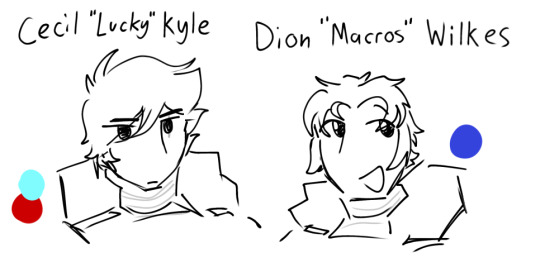
old images

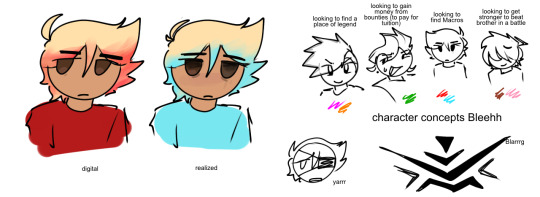
- this DOES take place in the rvb universe, but it’s really so not important other than the red and blue fighting aspect and the sword bonding aspect. since they touch it at the same time it’s bonded to both of them and it deactivates if they’re not both close to it
- as I mentioned before, this was made as an elaborate joke to trick a friend’s friend that a new season of rvb was being released. and look where we are now.
- i actually had a song playlist for them but it’s only like 6 songs so who cares
- while I wrote most of the script, the other person in this project was the one making most of the ideas for what the episodes should be. i think I made the majority of the large plotpoints tho
- season 2 would have entailed lucky waking up from a coma. never stated directly but it came from a joke about him getting the bubonic plague so I guess it was that. macros, or the Medical Assistance Computer and Revisionary Operating System, goes onto his next patient. Lucky is now trying to find where Battle Canyon is in the Real World so he can meet up again with Macros. He then meets up with a group of misfits who all have their own reasons to travel around space. The system with simulated IS simulated in a real space, and uses the red and blue battles as a stalemate to keep patients conscious and stimulated. takes place after s13 I think. Yeah I know I know it was all a dream cliche as fuck especially in the context of rvb but…come on.
that’s it heres a video I made of them without my controller connected so I couldn’t put my weapon down and the movements are crazy
25 notes
·
View notes
Note
Sorry, sorry. I know you probably have already answered this a million times, but I need food suggestions. Idkkk I have just been feeling yuck & bloated asf. I also have like zero desire for complexity anymore palate wise which idk maybe not a good nor bad thing & just a reflection on what I need rn spiritually or maybe I've just become boring & jaded in all aspects and need that palate shock again. I loved how you linked some of your meals before to your Aquarius placements, so if it helps I'm like all sag (ven, sun, merc, pluto) and aqua (mars, rising, uranus, neptune) w like a cancer moon (out of bounds) & Gemini saturn..
oh slay we actually sound really compatible lol. aquarius rising power foods are celery and cherries and the cell salt is sodium chloride which is literally just salt but because aquarius is really liable to issues to do with water retention and edema (the water carrier archetype literally) i also think like potentially a really low salt diet works vghbjnkm. + coconut water. if you eat meat then marine proteins and just general like space food energy like mousses, cheesecake, coco de nata, things shaped like spheres, metallic food, popping candy, jelly suspended in liquid style asian drinks. sprite is very air sign like lemonade>lemon water. also because of the uranus dominion over aquarius i think there's like a reactionary/revisionary quality to the foods good for charging aquarius like back to simplicity/avoiding fads somehow like white rice is better than brown rice in that case. white bread over sourdough etc. also like air placements generally i really am drawn to food which is like bird food like sesame snaps and overdose level seed crackers. lettuce and vegemite sandwiches period. sagittarius not so sure i know the foods from the website i use are watermelon and eggplant lol but also land food that would be hunted like idefk i don't eat meat but like lamb ig? fucked but yeah. most sagittarius men i know are really obsessed with meat but also like suicidal every other week and it's kinda yuck so idk. anything black like bbq, liquorice, black coffee, squid ink, spicy fast foods, rich sauces like that vibe. but potentially through the like dosha framework from ayurveda natural inclination is something to work against idk there's like this whole thing im experiencing mentally having an ego death about nutrition realising it's not remotely aspirational and in fact is just like endlessly shifting cycles of yourself reacting to the environment and yourself. so idk. think of air and fire, and ways to increase the energised or fast parts of those elements ig which you can even begin by doing by like eating more intense spices, more stimulating food, working on enteric nervous system consciousness and idk. aquarius needs exercise. sagittarius is like. energy drink energy
2 notes
·
View notes